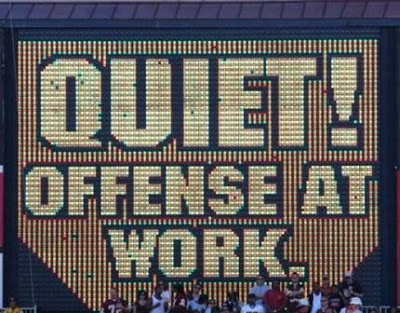Who protects their house? Since 2000, the strength of home field advantage has varied league-wide.
**All statistics are regular season only. Houston has been adjusted to account for not existing in 2000 or 2001**
2000 - 54.0%
2001 - 54.0%
2002 - 58.0%
2003 - 61.3%
2004 - 56.6%
2005 - 59.0%
2006 - 53.1%
2007 - 57.4%
2008 - 57.2%
These teams protect their house the best, winning the highest percentage of their home games:
Team - Wins - Win Pct.
IND - 53 - 0.736
NE - 53 - 0.736
BAL - 52 - 0.722
PIT - 51.5 - 0.715
DEN - 50 - 0.694
MIN - 47 - 0.653
GB - 47 - 0.653
SEA - 47 - 0.653
PHI - 46 - 0.639
TB - 45 - 0.625
TEN - 44 - 0.611
CHI - 44 - 0.611
SD - 43 - 0.597
KC - 42 - 0.583
DAL - 42 - 0.583
MIA - 41 - 0.569
STL - 40 - 0.556
NYG - 39 - 0.542
NYJ - 39 - 0.542
JAX - 39 - 0.542
CAR - 37 - 0.514
WAS - 37 - 0.514
SF - 37 - 0.514
ATL - 37 - 0.514
ARI - 36 - 0.500
CIN - 35.5 - 0.493
BUF - 35 - 0.486
HOU - 26 - 0.464
OAK - 33 - 0.458
NO - 32 - 0.444
CLE - 28 - 0.389
DET - 27 - 0.375
But the home winning percentage is less telling than the percentage of a team's wins that come at home. In other words, is a team collecting its wins primarily at home or on the road?
DET 67.5%
ARI 65.5%
HOU 65.0%
KC 63.6%
MIN 63.5%
CIN 61.2%
SF 60.7%
DAL 59.2%
BUF 58.3%
DEN 58.1%
SEA 58.0%
CHI 57.9%
BAL 57.8%
SD 57.3%
TB 57.0%
MIA 56.2%
JAX 55.7%
WAS 55.2%
STL 54.8%
ATL 54.4%
OAK 54.1%
GB 54.0%
CLE 53.8%
NYJ 53.4%
TEN 51.8%
PIT 49.5%
IND 49.1%
CAR 48.7%
NE 45.7%
PHI 45.1%
NO 44.4%
NYG 44.3%
You might be surprised to see some good teams at the bottom of the list, including Pittsburgh, Indianapolis, New England, Philadelphia and the New York Giants. These teams are typically in the playoff hunt, yet they win more games on the road than at home.

On the other hand, there are some bad franchises at the top of the list, headlined by Detroit, Houston, Kansas City and Cincinnati.
What might explain this? While there are far too many variables to make any definitive conclusions, I have two theories. First, teams that are traditionally good enjoy less of a home field advantage than those who are typically bad. In most recent seasons, New England, Pittsburgh and Indianapolis fans have been basically hoping to get through the season with limited injuries so they can enjoy the playoffs. It takes less to excite these fans.
As for the bad teams at the top, a bad team is more likely to be affected by hostile crowds on the road. Also, a "good" team should actually be towards the 55-60% mark and not higher, because a good team should be able to take advantage of the luxuries of home crowd noise, but not be rattled when on the road. Teams over 60% might lose predominately more on the road due to distractions and hostile crowds.
Does anyone else have a theory to explain the numbers?

6 Responses:
Also if you team has won around 3 games in the last 2 or 3 seasons like the lions then having 67 percent of your wins at home seems about right
That's true. I have the breakdown of home wins by team by season. The Lions have won 4, 2, 3, 5, 3, 3, 2, 5, and 0 games at home each year.
I think you miscounted the NYG-NO game after Hurricane Katrina.
I used the NFL's official "home" designation.
It should make sense that the best teams would win a little over half of their games at home. Teams that are top of the league are winning probably 11 or 12 games per year such as the Colts who had 10, 6, 10, 12, 12, 14, 12, 13, and 12 for an average of about 11 wins per year. with 8 home games and 8 away games a year that means they are winning about 5 or 6 games a year at home. This shows their versatility to win on the road, and I would think that what sets apart the top tier teams from the lower to mid range teams of the league who can maybe only win 1 or 2 games a year on the road. This means they could win only 8-10 games a year but more likely 7-9 games a year which would put them in the mid range of the league, but the likely hood of a team being able to win all their home games or away games is very slim so the teams who are going to be tops of the league are going to be winning a little over half of their home games and a little of half their away games as opposed to a little over half their home games
I wanted to give Brien enough time to point out that his beloved Steelers never play a "road" game since every city is Steelers Country. That would explain the 50-50 distribution.
Post a Comment